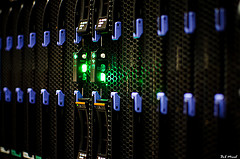 Out of sight, out of mind. The cloud is invisible to users, so it’s easy to think of it as non-existent in some ways. That impression is exacerbated by industry hype that emphasizes the greater efficiency and savings of cloud computing for users – no equipment to buy and maintain, and no related overhead.
Out of sight, out of mind. The cloud is invisible to users, so it’s easy to think of it as non-existent in some ways. That impression is exacerbated by industry hype that emphasizes the greater efficiency and savings of cloud computing for users – no equipment to buy and maintain, and no related overhead.
All that cloud data has to live somewhere, despite the fact that it’s no longer stored on individual company servers. So we now have tens of thousands of huge data centers around the world. That adds up to hundreds of thousands of square feet of servers, all of which require extensive and carefully controlled cooling systems.
So here’s what no one tells you about cloud and data centers: they are far from gentle giants.
An “industry dirty secret.”
That’s how one industry watcher described the monumental energy usage of cloud and data centers in a New York Times article published in late 2012. The source went on to suggest that, if data centers were a manufacturing industry, they would be put out of business immediately.
The hardware that hums along inside each data center consumes tremendous amounts of electricity, much of which is wasted because the functional need for cloud computing and data centers fluctuates, but providers have to be prepared for the highest peak demand. Data centers sometimes waste as much as 90% of the electricity they take from the grid.
In 2012, data centers were using about 30 billion watts of electricity, which industry experts compared to the output of 30 nuclear power plants. American data centers were responsible for a full third of that load.
Facebook’s data center in Prineville, Oregon, relies on a fleet of huge diesel generators to ensure continuity in the event of a power failure. This is the industry norm. At another data center, the six generators in use could provide enough electricity to supply a community of 7,000 people.
Unfortunately, diesel generators exhaust toxic emissions into the environment. According to the Times article, a number of data centers in Silicon Valley were actually listed on California’s Toxic Air Contaminant Inventory which identifies stationary diesel polluters.
The biggest of the biggest are making changes.
Cloud-based giants are funding and implementing innovative alternatives they hope will support the continued growth of cloud computing and data centers with a less-damaging footprint. Amazon and Microsoft cool their data centers with hydroelectric power, which is a common electricity source in the Pacific Northwest.
Google, which indexes and stores more than 20 billion pages of data every day worldwide, is using recycled waste water to cool the thousands of servers housed in its new Atlanta data center. They’re purifying the excess waste water and releasing it into the Chattahoochee River, similar to a process they pioneered at one of their facilities in Belgium.
The National Security Agency announced earlier this year that they also plan to use as much as 5 million gallons of gray water per day to cool their vast Maryland data center. But this solution simply creates new challenges: the enormous amount of water needed to cool these facilities is putting strain on local water supplies and sewer capacity. And data center managers are having to become water management experts.
EBay is taking another route, hoping to achieve greater efficiency for their cloud computing and data centers by using solid oxide fuel cells to produce electricity. The cells use an electrochemical process that combines natural gas, steam air and high operating temperatures.
So while the cloud is still touted as the ultimate in environmental friendliness and modern efficiency, the truth is cloud computing and data centers are putting massive and growing pressure on power generation resources. Will effective solutions be developed and put into place in time to avoid a collision of computing desire and availability? We’ll have to wait and see.
Photo Credit: @small_realm via Flickr.

